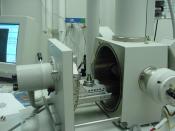Magnification and Resolution
Magnification is how much bigger a sample appears to be under the microscope than it is in real life.
Overall magnification = Objective lens x Eyepiece lens
Resolution is the ability to distinguish between two points on an image.
÷ The resolution of an image is limited by the wavelength of radiation used to view the sample.
÷ This is because when objects in the specimen are much smaller than the wavelength of the radiation being used, they do not interrupt the waves, and so are not detected.
÷ The wavelength of light (min. - violet is 400nm) is much larger than the wavelength of electrons, so the resolution of the light microscope is a lot lower.
÷ The actual resolution is often half the size of the wavelength of radiation used. Thus, for the light microscope the maximum resolution is about 200nm.
÷ In other words, if two objects in the specimen are closer than 200nm in real life, then they will only show up as one object on the image.
÷ Using a microscope with a more powerful magnification will not increase this resolution any further. It will increase the size of the image, but objects closer than 200nm will still only be seen as one point.
Light Microscopy
The light microscope is the main tool which has been used to look at biological specimens for many years and is still very much in use today. Very small subjects, such as bacteria, can be looked at whole under a microscope, but larger tissues must first be chemically preserved, embedded in wax, sliced very thinly, mounted on glass slides and stained before viewing. Some semi-translucent specimens, such as the chick and zebrafish embryos, can be looked at whole under microscopes specially designed for this purpose. In...


